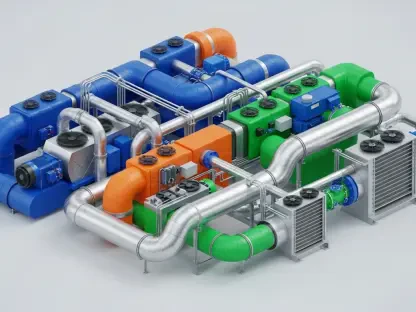Setting the Stage for Network Evolution
Imagine a sprawling manufacturing facility where a single network glitch can halt production lines, costing thousands of dollars per hour in downtime, and in an era where digital transformation drives industrial operations, the stakes for network reliability have never been higher. Predictive network monitoring emerges as a game-changing technology, promising to shift the paradigm from reactive crisis management to proactive issue prevention. This review delves into the core of this innovative approach, exploring its capabilities, real-world impact, and the challenges it faces in the manufacturing sector. The focus is on how this technology can safeguard operational efficiency and security amidst growing cyber threats and complex system integrations.
Understanding the Concept
Predictive network monitoring represents a significant leap forward in network management by leveraging advanced analytics to anticipate issues before they occur. At its essence, this technology uses data-driven insights to identify potential disruptions, moving away from traditional methods that only respond after a problem arises. Its relevance is particularly pronounced in industries like manufacturing, where the convergence of Information Technology (IT) and Operational Technology (OT) creates both opportunities and vulnerabilities that demand smarter oversight.
The emergence of this approach is closely tied to the broader wave of digital transformation sweeping through industrial environments. As factories become more connected, the need to monitor and secure networks across diverse systems has grown critical. Predictive monitoring addresses this by offering a framework that not only detects anomalies but also forecasts risks, enabling organizations to maintain seamless operations in an increasingly complex landscape.
Core Components and Mechanisms
Bridging IT and OT Systems
A cornerstone of predictive network monitoring lies in the integration of IT and OT systems, which historically have operated in isolation. IT focuses on data security and network performance, while OT prioritizes production continuity. Bringing these domains together enhances visibility across the entire network, allowing for a unified response to potential threats and inefficiencies, though it often reveals gaps in legacy infrastructure that must be addressed.
This convergence, however, is not without hurdles. Legacy machinery, often lacking modern security features, can introduce vulnerabilities when connected to broader networks. Additionally, discrepancies in priorities between IT and OT teams can hinder effective collaboration, necessitating robust strategies to align goals and improve data sharing for a more resilient monitoring framework.
Leveraging Predictive Analytics and Alerts
Central to the technology’s effectiveness is its use of predictive analytics, which analyzes historical and real-time data to forecast network disruptions. By identifying patterns and anomalies, these systems can predict failures in critical components like Programmable Logic Controllers (PLCs), enabling preemptive action. The precision of these forecasts significantly reduces the likelihood of unexpected downtime, a costly issue in industrial settings.
Intelligent alerting mechanisms complement analytics by providing timely notifications tailored to specific risks. Unlike traditional alarms that react to issues as they happen, these alerts prioritize potential problems based on severity and likelihood, ensuring that maintenance teams focus on the most pressing concerns. This proactive approach has proven instrumental in maintaining operational stability across various applications.
Emerging Trends Shaping the Field
The landscape of predictive network monitoring is rapidly evolving, driven by advancements in machine learning and automation. These innovations enable systems to learn from past incidents and continuously refine their predictive accuracy, offering a dynamic defense against emerging threats. As algorithms become more sophisticated, the ability to anticipate complex issues improves, marking a shift toward more autonomous network management.
Another notable trend is the industry’s growing emphasis on proactive strategies amid rising cyber threats like ransomware, which disproportionately target manufacturing due to high downtime costs. Organizations are increasingly adopting integrated monitoring solutions to counter these risks, reflecting a broader recognition of the need for preemptive security measures in a digitally connected world.
Real-World Impact and Case Studies
In practical settings, predictive network monitoring has demonstrated tangible benefits, particularly in manufacturing. Industries reliant on continuous production have embraced this technology to safeguard against disruptions, with many reporting significant reductions in unplanned outages. The ability to foresee issues before they escalate translates directly into cost savings and improved reliability.
A striking example comes from an aerospace manufacturer that utilized predictive monitoring to detect a misconfigured PLC before it triggered a production halt. This early intervention averted an estimated 24 hours of downtime, underscoring the technology’s dual role in enhancing both operational efficiency and security. Such cases highlight how predictive tools can transform potential crises into manageable events.
Challenges and Limitations
Despite its promise, predictive network monitoring faces several obstacles that hinder widespread adoption. Technical challenges, particularly with integrating outdated legacy systems, pose significant barriers, as these systems often lack the necessary protocols for seamless connectivity. Upgrading or retrofitting such infrastructure requires substantial investment and expertise, slowing implementation in many organizations.
Organizational issues also play a critical role, with silos between IT and OT teams creating blind spots in network oversight. These divisions can exacerbate vulnerabilities, especially as cyber threats grow more sophisticated. Moreover, regulatory constraints and market resistance to new technologies add layers of complexity, though ongoing collaborations aim to address these through standardized solutions and shared best practices.
Future Outlook for the Technology
Looking ahead, predictive network monitoring holds immense potential for further innovation, particularly in automation and cybersecurity. Developments in these areas could lead to fully autonomous systems capable of not only predicting but also resolving issues without human intervention. Such advancements would mark a significant milestone in operational resilience, especially for industries under constant threat of disruption.
The long-term vision includes a deeper integration of monitoring tools across diverse industrial sectors beyond manufacturing. As cyber defenses evolve, the technology is expected to play a pivotal role in safeguarding critical infrastructure, with scalability and adaptability becoming key focus areas for developers and adopters alike over the coming years.
Reflecting on the Journey
Looking back, this exploration of predictive network monitoring revealed a technology that stands at the forefront of transforming industrial network management. Its ability to anticipate disruptions and bridge critical system divides marks a departure from outdated reactive methods. The real-world successes, balanced against persistent challenges, paint a picture of a tool with undeniable value yet in need of refinement. Moving forward, stakeholders should prioritize fostering IT-OT collaboration and investing in scalable solutions to overcome legacy barriers. Embracing pilot programs to test integration strategies could pave the way for broader adoption, ensuring that industries not only keep pace with digital transformation but also stay ahead of evolving threats.









